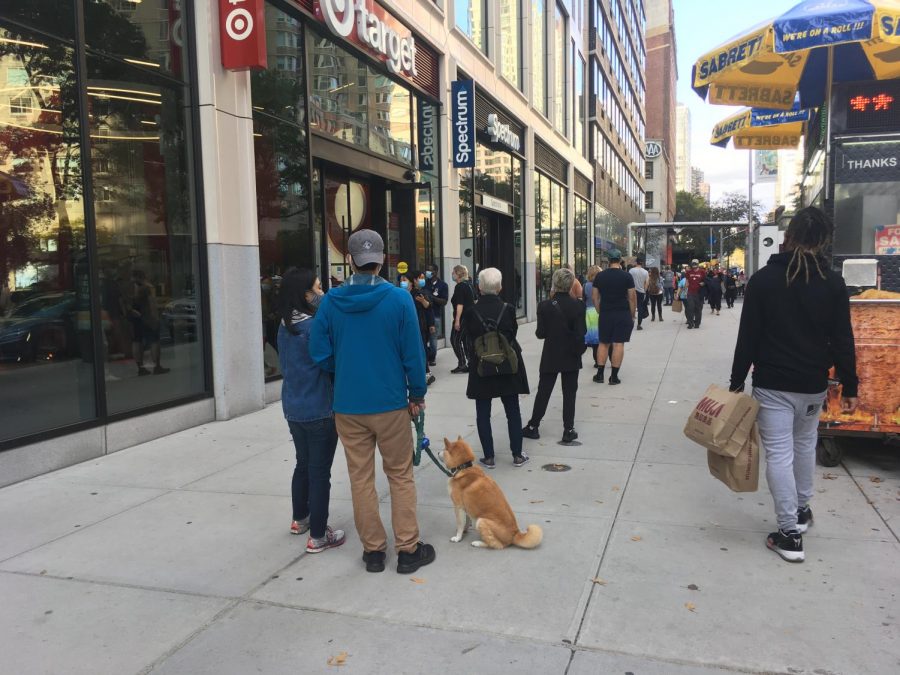Civic Duty and Social Distancing: Preventing Coronavirus Spread Among Voters
Early voting has been open in New York as of Oct. 24, and lines like this one stretch for several blocks.
October 28, 2020
Voting is a right that every eligible American citizen should have the opportunity to exercise. For the upcoming presidential election, there are three ways to vote: by mail, early in person or in person on Election Day on Nov. 3.
In what some are calling the most important election of our time, major corporations and prominent figures alike have actively promoted voter registration and turnout. To contend with risks associated with COVID-19, however, an unusually high number of people will be voting by mail, upwards of 50%, as opposed to the usual 25%. Still, for several different reasons, this isn’t an option for many. Here’s how you can stay safe no matter which method you use to vote.
Know Your Risks
The best thing you can do during this pandemic is to keep yourself informed. When it comes to voting, deciding when and where you vote can be crucial. To help you stay safe, you can make a voting plan. In addition to checking your status as a registered voter, you should know where you’re going to vote (or how you plan to mail your ballot), and set aside a time that not only fits in your schedule but is around a time when fewer people will go to the polls.
In order to reduce your chances of getting stuck in a line of people, go to the voting booths during non-peak hours, such as mid-morning. While that might depend on where you live, most people tend not to vote until later in the day.
Also, knowing how your local county is handling the virus can help you make an informed decision on where you want to vote. You can check up-to-date information about your county’s COVID-19 situation at the Johns Hopkins Coronavirus Resource Center.
Voting By Mail
While all 50 states have always offered the option to vote by mail, there generally needs to be a reason. This year, because of coronavirus, in all but five states (Texas, Louisiana, Mississippi, Tennessee and Indiana), voters have been able to request a mail-in ballot due to COVID-19 fears. There’s considerable debate about whether or not voting by mail is the most secure or reliable option, but in terms of avoiding contact with other people, it is likely the safest.
If you plan to vote by mail, be sure to check your state’s requirements regarding dates and ballot validity. In the state of New York, the list of qualifications that allow one to vote by mail include an inability to appear due to illness or disability. This includes the risk of contracting or spreading COVID-19, which applies to essentially everyone in this case.
Voting in Person Before Election Day
One way to minimize contact with others is to exercise your right to vote early. Check your local area to see when and where early voting is available near you.
New Yorkers can vote early starting Oct. 24. If you plan on voting in person, this may be preferable to waiting until Nov. 3 because there will likely be shorter lines and fewer people for you to interact with.
Voting in Person on Election Day, Nov. 3
Arguably the riskiest way to vote during this pandemic, visiting the polls on Election Day will likely remain a popular option since voting by mail or early isn’t accessible for everyone.
To save time and reduce potential contact with others, prepare all required documentation beforehand. Check your state’s voting requirements to see what you need to bring.
In the state of New York, no documentation is required to vote. In fact, New York voters don’t need to present an ID to vote as long as they provided one when registering to vote. However, many states have different guidelines on required documentation, so it is important to check first.
When you arrive at the polling station, be sure to follow guidelines from the Centers for Disease Control and Prevention, like wearing a face mask and physically distancing from fellow voters. If possible, bring and use hand sanitizer after touching any surfaces or documents.
Although the transmission rate for COVID-19 via surfaces is low, the use of sanitizer diminishes this risk further. Officials also recommend that voters bring their own pen to discourage using communal ones. Also, you could bring a Q-tip or gloves to touch any electronic screens instead of using your fingers.
All three options have unique benefits and drawbacks. In terms of COVID-19 safety, voting by mail is likely the best option due to decreased contact with other individuals. However, due to controversy regarding the collection of late ballots and other factors, voting in person may be a more surefire way to make sure that your vote is counted. Voting early in person will likely offer more protection from COVID-19 due to lower turnout, but one can still vote safely on Election Day by adhering to proper precautionary measures.
It’s important to vote, but it’s also important to stay safe. Following the proper guidelines and sticking with your voting plan can help you stay safe while you vote in this 2020 presidential election.

















